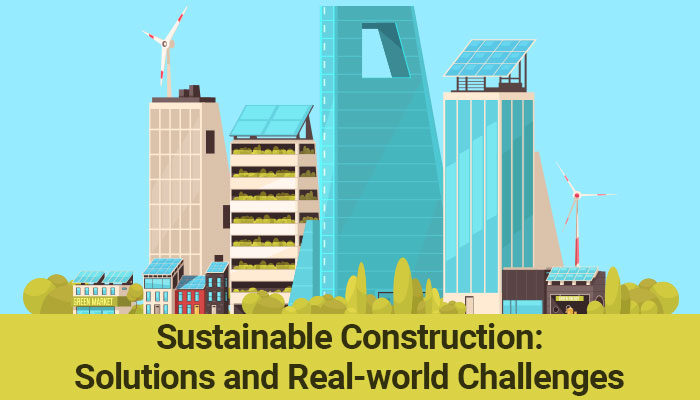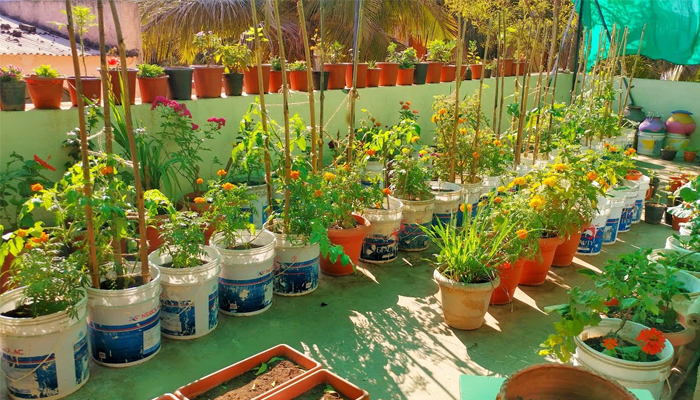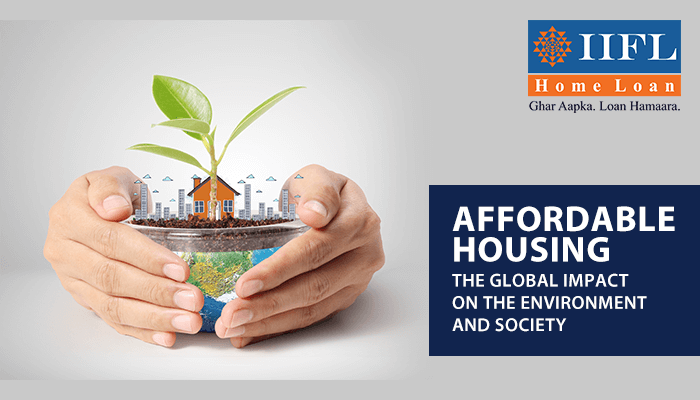Gender-Inclusive Fiscal Incentives for Green Affordable Housing in India

Along with the rapid growth of the population, comes an increasing demand to meet the various needs of the citizens, especially the need for affordable housing. However, high building costs and high land costs make housing unaffordable for a larger section of the population. According to the 12th Five Year Plan (2012-17), 18.78 million people still lack housing in urban India.1 With global warming rapidly increasing, it becomes even more necessary to invest in green building mechanisms. Green buildings can effectively reduce and eliminate the harmful effects of climate change while providing benefits to the environment, society and economy. There are cost-savings on utility bills for inhabitants, lesser carbon emissions during and after construction, better property values and long-term health benefits.
Economically Weaker Sections (EWS) struggle immensely with access to affordable housing. Women have to furthermore face greater burdens due to a lack of access to housing. While as per Indian law, women have equal rights of inheritance to property, the reality of it is quite contrasting. Socially and culturally, still women are not accorded equal respect and standing as men. This causes them to lose out on significant economic and social benefits.
Affordable Housing Schemes under ‘Housing for All’
The Government launched two affordable housing schemes in 2015, the Pradhan Mantri Awas Yojana – Gramin (PMAY-G) and the Pradhan Mantri Awas Yojana – Urban (PMAY-U). The goal of ‘Housing for All’ aims to develop affordable houses with basic amenities like toilets, water supply, electricity and gas connections.2 There are also several tax incentives for affordable housing – buyers of affordable housing are eligible for a deduction of upto ₹ 2 lakhs from taxable income under Section 24 of the Income Tax Act as well as an additional deduction of ₹ 1.5 lakhs under Section 80 EEA.3 However, there are still gaps when it comes to accessibility and affordability, especially for the EWS category. A majority of loans which are dispersed by Housing Finance Companies (HFCs) go to mid-income and high-income groups who exist in the bracket of above ₹ 10 lakhs.4 Moreover, a large percentage of workers in urban areas work in the unorganised sector; they lack formal documentation and access to bank accounts, hence making it more difficult for them to access loan facilities. Therefore, the salaried middle- and high-income households are the ones who benefit more from these loan and incentive programmes. In addition to the limited loan amounts that are available and the banks' propensity to avoid lending to low-income households, the lack of tax benefits for this group of borrowers raises the cost of loans above what it otherwise would have been.
Women Ownership or Co-ownership of the House
These schemes also promote home ownership amongst women; at least one woman member of the family must be registered as the owner of a new house.5 Women borrowers can also get partial waivers on stamp duties, tax benefits and avail of interest rate concessions.6 However, considering cultural and social bindings for women in India, it becomes difficult for them to access such schemes for their benefit. Women may be doing a majority of household activities but home ownership and heading the household are still difficult-to-achieve concepts for them. Women face an array of issues within their households, from general discriminatory practices to serious abuse. Women belonging to minority groups such as scheduled Castes, scheduled Tribes, EWS and women who are abandoned, older or widowed are even more likely to be marginalised and removed from much-needed housing, ownership and fiscal benefits owing to inadequate government regulations over access to laws and equal opportunities.7 Even single mothers and single women, who may be the head of their household, could be in a situation where their family is not formally recognised, resulting in them being blocked from housing programmes.8 Women also frequently have trouble getting mortgage loans. According to a study from 2017, only 3% of women have unpaid house loans, and only 5% of women have borrowed money from a formal financial institution.9
Encouraging Gender Inclusivity via Fiscal Policies
Approaching fiscal policy decisions with a gendered lens becomes essential to make them more inclusive. Such decisions provide women with more economic opportunities, boost growth, and lessen poverty and inequality. Not only accessible housing schemes but individual-based tax systems, better investments in education and infrastructure and improved economic opportunities should be the focus to address gender parity. Policies which focus on providing economic benefits to women for generally unpaid labour work and promotion to increase women’s participation in the labour force would increase women’s autonomy in the household. By converting the personal income tax system from a family to an individual one, it is possible to eliminate tax distortions for the family member who makes the lower income, who could be a woman. This will encourage more women to work, and a more diverse workforce will foster new and creative ideas that will increase productivity. Fiscal policies that take into account gender raise productivity leads to sustainable growth. Fiscal measures ought to be able to close gaps, boosting female productivity and ultimately preparing more women for careers in fields requiring higher levels of expertise.
For these measures to be successful, it is essential to address existing gaps and issues in gender scenarios as well as housing. Accurate and sufficient gender-disaggregated statistics are crucial. Data on ownership and access rights must be gathered, especially keeping in mind women’s rights to land and home ownership. Incorporating gender equality into housing regulations will also facilitate the empowerment of women and make it possible for them to access safe and affordable homes. Public agencies should step up to promote equalising efforts. Collaboration and shared vision among various stakeholders, including the public, private, and civil society organisations, will be essential. Most importantly, it should be ensured that women are adequately represented in decision-making processes and actively involved on a large scale.
Contributing to this movement, the Asian Development Bank (ADB) and IIFL Home Finance Limited (IIFL HFL) signed a $68 million loan (in equivalent Indian rupee).10 This initiative aims to improve financial access to affordable green housing for women borrowers from lower-income groups in India. The funding is a joint loan consisting of a direct ADB loan of up to $58 million and a $10 million concessional loan by the Canadian Climate Fund for the Private Sector in Asia (CFPS). From ADB’s loan, 80% will be earmarked for lending to women borrowers or co-borrowers and 20% allocated to financing mortgages for green-certified homes. The CFPS loan will support IIFL HFL’s green housing portfolio, specifically towards incentivizing developers to adopt green certification standards in building affordable housing.11
Apart from making a home out of a house, women should also own it! Don't you think? Share your thoughts in the comments section.
Sources
-
India Planning Commission. (2013). Twelfth Five Year Plan.
-
PMIndia. (2015). “Housing for All by 2022” Mission – National Mission for Urban Housing.
-
Motiani. (2022). You must get loan for affordable housing before March 31 to get this tax break.
-
Mayank et al. (2012). Affordable Housing in India - An Inclusive Approach to Sheltering the Bottom of the Pyramid.
-
Pradhan Mantri Awas Yojana – Urban. (2015). Pradhan Mantri Awas Yojana – Urban; About.
-
Ramnani. (2018). Women homebuyers get preference under PMAY, interest concession by banks.
-
Chavan. (2020). Women's Access to Banking in India: Policy Context, Trends, and Predictors.
-
Asian Development Bank. (2022). ADB Signs $68 Million Loan with IIFL Home Finance to Boost Women’s Access to Affordable Green Housing in India.
-
Asian Development Bank. (2022). ADB Signs $68 Million Loan with IIFL Home Finance to Boost Women’s Access to Affordable Green Housing in India.
-
Office of the United Nations High Commissioner for Human Rights. (2012). Women and the Right to Adequate Housing.
-
Office of the United Nations High Commissioner for Human Rights. (2012). Women and the Right to Adequate Housing.
Additional Sources
-
Asian Development Bank. (2022). ADB Signs $68 Million Loan with IIFL Home Finance to Boost Women’s Access to Affordable Green Housing in India. Available at: https://www.adb.org/news/adb-signs-68-million-loan-iifl-home-finance-boost-women-s-access-affordable-green-housing-india
-
Chavan. (2020). Women's Access to Banking in India: Policy Context, Trends, and Predictors. Available at: http://www.ras.org.in/women_s_access_to_banking_in_india
-
India Planning Commission. (2013). Twelfth Five Year Plan. Available at: https://niti.gov.in/planningcommission.gov.in/docs/plans/planrel/fiveyr/12th/pdf/12fyp_vol1.pdf
-
Mayank et al. (2012). Affordable Housing in India - An Inclusive Approach to Sheltering the Bottom of the Pyramid. Available at: https://smartnet.niua.org/sites/default/files/resources/Affordable_Housing_in_India_2012.pdf
-
Motiani. (2022). You must get loan for affordable housing before March 31 to get this tax break. Available at: https://economictimes.indiatimes.com/wealth/tax/you-must-get-loan-for-affordable-housing-before-march-31-to-get-this-tax-break/articleshow/89658321.cms
-
Office of the United Nations High Commissioner for Human Rights. (2012). Women and the Right to Adequate Housing. Available at: https://www.ohchr.org/sites/default/files/WomenHousing_HR.PUB.11.2.pdf
-
PMIndia. (2015). “Housing for All by 2022” Mission – National Mission for Urban Housing. Available at: https://www.pmindia.gov.in/en/news_updates/housing-for-all-by-2022-mission-national-mission-for-urban-housing/
-
Pradhan Mantri Awas Yojana – Urban. (2015). Pradhan Mantri Awas Yojana – Urban; About. Available at: https://pmay-urban.gov.in/about
-
Ramnani. (2018). Women homebuyers get preference under PMAY, interest concession by banks. Available at: https://www.moneycontrol.com/news/business/real-estate/women-homebuyers-get-preference-under-pmay-interest-concession-by-banks-2523671.html
Tags
Disclaimer: The information contained in this post is for general information purposes only. IIFL Home Finance Limited (including its associates and affiliates) ("the Company") assumes no liability or responsibility for any errors or omissions in the contents of this post and under no circumstances shall the Company be liable for any damage, loss, injury or disappointment, etc. suffered by any reader. All information in this post is provided "as is", with no guarantee of completeness, accuracy, timeliness, or of the results, etc. obtained from the use of this information, and without warranty of any kind, express or implied, including, but not limited to warranties of performance, merchantability, and fitness for a particular purpose. Given the changing nature of laws, rules, and regulations, there may be delays, omissions, or inaccuracies in the information contained in this post. The information on this post is provided with the understanding that the Company is not herein engaged in rendering legal, accounting, tax, or other professional advice and services. As such, it should not be used as a substitute for consultation with professional accounting, tax, legal or other competent advisers. This post may contain views and opinions which are those of the authors and do not necessarily reflect the official policy or position of any other agency or organization. This post may also contain links to external websites that are not provided or maintained by or in any way affiliated with the Company and the Company does not guarantee the accuracy, relevance, timeliness, or completeness of any information on these external websites. Any/ all (Home/ Loan Against Property/ Secured Business Loan/ Balance Transfer/ Home Improvement Loan/ NRI Home Loan/ Home Loan for Uniformed Services) loan product specifications and information that may be stated in this post are subject to change from time to time, readers are advised to reach out to the Company for current specifications of the said (Home/ Loan Against Property/ Secured Business Loan/ Balance Transfer/ Home Improvement Loan/ NRI Home Loan/ Home Loan for Uniformed Services) loan.
 Login
Login






















